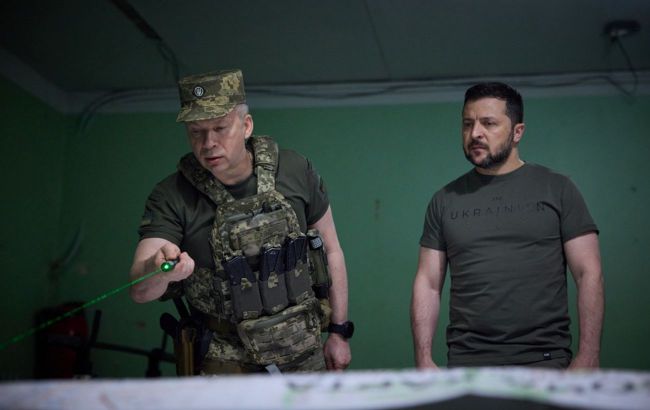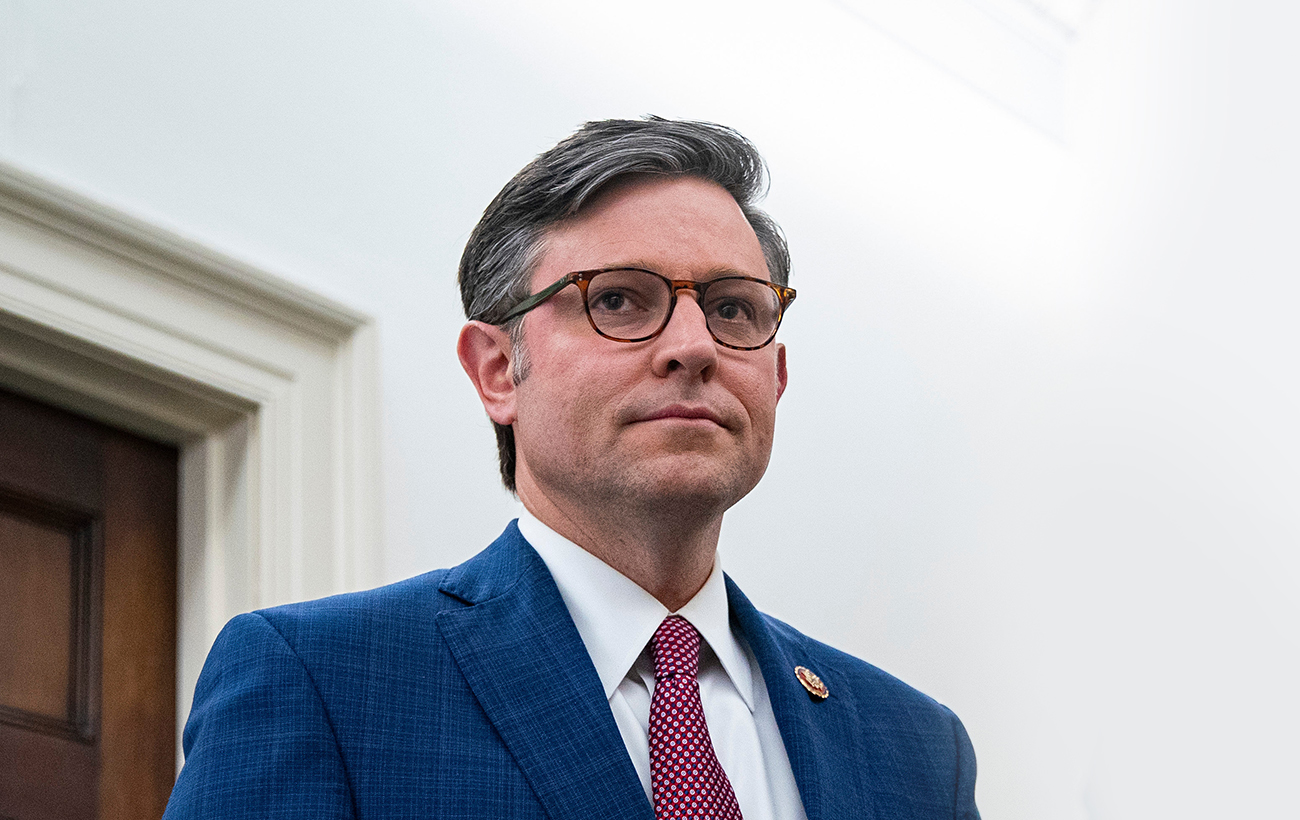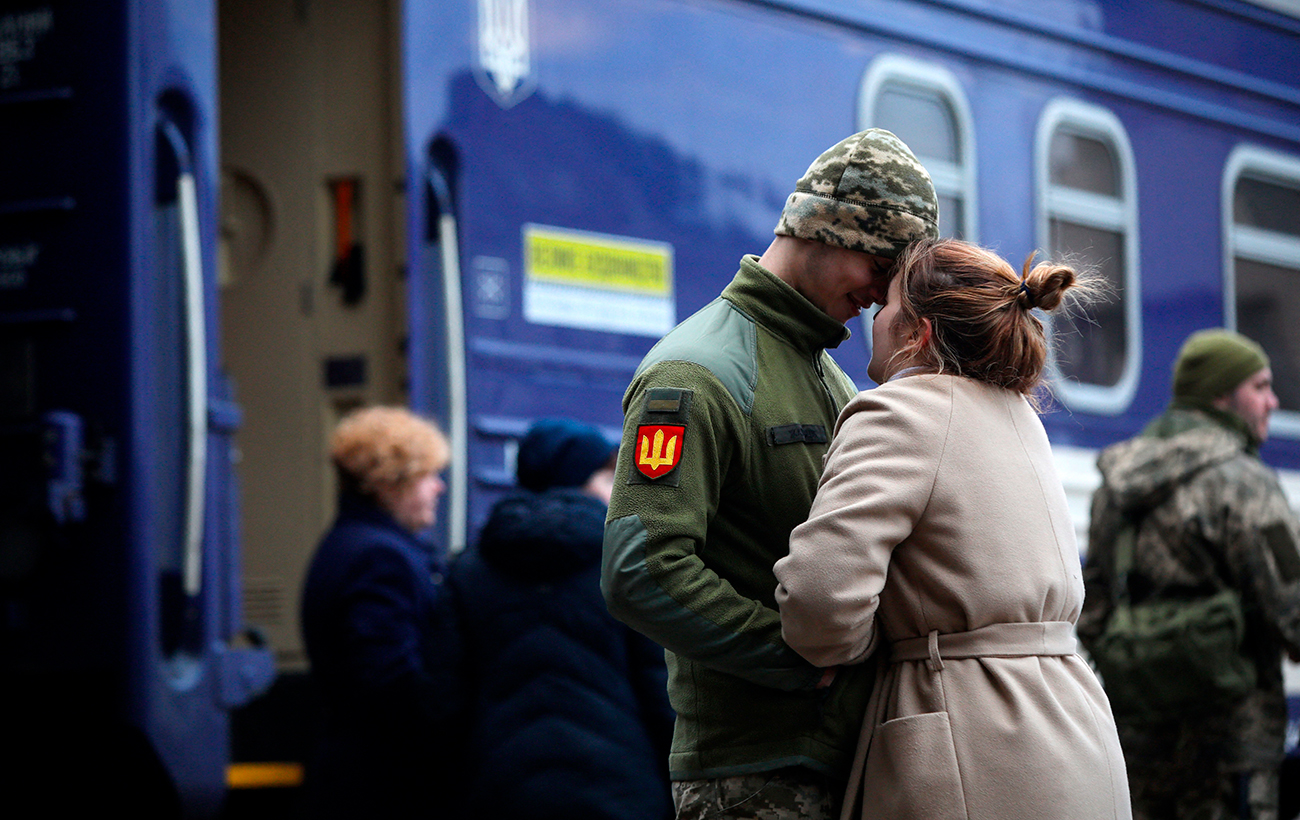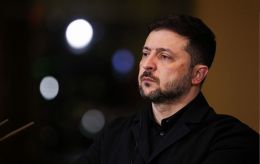Defense or victory: Anticipating Ukraine's third year of war
 Photo: Commander-in-Chief of the Armed Forces Oleksandr Syrskyi and President Volodymyr Zelenskyy (president.gov.ua)
Photo: Commander-in-Chief of the Armed Forces Oleksandr Syrskyi and President Volodymyr Zelenskyy (president.gov.ua)
Ukraine has shifted to a strategic defense on the front, but the delay in Western assistance raises doubts about its ability to defend effectively. Experts and officials lean towards the belief that this year will be spent rebuilding strength and preparing for a major offensive as early as 2025.
Find out more about what the third year of full-scale war will be like and what to prepare for in this material.
The material was prepared using analysis from experts at the Carnegie Endowment for International Peace, the European Council on Foreign Relations (ECFR), statements from the Commander-in-Chief of the Armed Forces of Ukraine, Olexandr Syrskyi, President Volodymyr Zelenskyy, Chief of the General Staff of the Armed Forces of Ukraine, Kyrylo Budanov, publications from The New York Times, The Wall Street Journal, ABC, comments from the Secretary of the National Security and Defense Council Committee, Roman Kostenko, and military expert Oleksandr Musiienko.
Transition to defense and main threats on the front
The course of the military year 2024 for Ukraine will be significantly influenced by the failure of the 2023 offensive, which did not replicate the success of operations in the Kharkiv and Kherson regions. In the fall of 2022, Ukrainian forces managed to liberate Balaklia, Izyum, Kupiansk, and Lyman, breaking through Russian defenses and advancing relatively deep with limited forces. Victory was then achieved in the battle for Kherson, under the fire of highly mobile rocket systems. The counteroffensive for 2023 was planned to reach the Sea of Azov or at least Melitopol (Zaporizhzhia region), but reality proved to be harsher.
Defense forces encountered much stronger fortified lines. Russia conducted mobilization, and increased troop numbers, and no longer were there instances where individual sections of the front were held by 2-3 understrength battalions, as in 2022. As noted by analyst Michael Kofman from the Carnegie Endowment for International Peace, overall, Russian forces performed much better in defense.
The three most significant factors were:
- Ukraine lacked superiority in firepower.
- The Armed Forces of Ukraine could not scale the application of forces, exploit breakthroughs, and generate momentum.
- Ukraine lacked the means to breach enemy lines and counter hostile aviation.
Ultimately, there was insufficient weakening or penetration of Russia's anti-tank capabilities, preventing the effective engagement of armored vehicles. Additionally, there were strategic aspects that exacerbated risks. The attempt to advance simultaneously on the Melitopol, Berdyansk, and Bakhmut axes led, according to analysts, to the stretching of artillery and the most experienced troops.
By October, the initiative had definitively shifted to Russia. The aggressor deployed large forces to capture Avdiivka. By the end of January, a critical situation had developed there, and in politics, the replacement of the Chief of the General Staff took center stage. President Volodymyr Zelenskyy explained the dismissal of Valerii Zaluzhnyi by stating that "certain things had not changed for a certain period," and the Armed Forces needed a reboot to become more technological and agile.
 Photo: General Oleksandr Syrskyi has a difficult task: to contain the Russians and inflict maximum losses on them (Getty Images)
Photo: General Oleksandr Syrskyi has a difficult task: to contain the Russians and inflict maximum losses on them (Getty Images)
His successor, General Oleksandr Syrskyi, announced the transition to a new stage of the war.
"We have transitioned from offensive actions to conducting a defensive operation. The goal of our operation is to exhaust the enemy, inflict maximum losses on them, using our fortifications, our technical advantages, unmanned aerial vehicles, electronic warfare systems, and maintaining prepared defense lines," he said in an interview with ZDF.
The enemy's rapid advancement and the threat of encirclement of the Defense Forces made this goal unattainable in Avdiivka, and they withdrew from the city last week. Thus, one of the most fortified areas, held for two years, fell. Active movement has now begun on other sections, and there are no signs of an operational pause yet.
As The New York Times writes, the Russian offensive has been divided into five attack lines. It is not excluded that the occupiers will try to press the Armed Forces to the west of Avdiivka; pressure is already being observed on Lastochkyne and Orlivka. It is still unclear how far they can advance and how strong Ukrainian fortifications are, but the next major populated areas are dozens of kilometers away.
A little south of the capture of Maryinka allowed the Russians to focus on another important stronghold - Vuhledar. Last year, they attacked from the south but suffered losses; now they are advancing from the north. And in the Zaporizhzhia region, they intend to recapture Robotyne ledge, assembling an estimated 50,000-strong force in this region. However, there is no such pressure as in Avdiivka, as the troops are spread along the entire line of fortifications. Dmytro Lykhoviy, spokesperson for the operational-strategic grouping Tavria, recently stated that if the enemy withdraws troops from the flanks, the Defense Forces could take advantage of this and move to new positions.
The other two sections from which the Russians are advancing are Kremenna and Bakhmut. In the first case, risks are being created for Kupiansk, territories on the eastern bank of the Oskil and Lyman rivers; in the second - for Chasiv Yar with subsequent access to Kostiantynivka, Druzhkivka, and Kramatorsk. Military experts interviewed by RBC-Ukraine named the Bakhmut direction as the most likely for the next mass assaults. But they agreed that in the coming weeks, attempts at enemy advancement would be across the entire front line.
Read more about this in the article "Five threats: Consequences of Ukrainian troops' withdrawal from Avdiivka and ability to resist Russian pressure."
The problem is that Ukraine lacks the military capabilities to confidently hold back the enemy along a 1000 km front line. President Volodymyr Zelenskyy directly stated that this was the result of the weakening of the main strategic partner, the United States.
What about Western aid, when will the F-16s arrive, and will there be an offensive only in 2025?
After several unsuccessful attempts in Congress to agree on aid, last week the American Senate supported a $95 billion package for Ukraine, Israel, and Taiwan. Of this amount, approximately $60 billion is allocated to support our country. The bill was approved by 70 Democrats and Republicans, exceeding the required minimum of 50 votes, and Democratic majority leader Chuck Schumer suggested that this time the House of Representatives would support the senators.
 Photo: the issue of billions for Ukraine from the United States largely depends on the position of the Speaker of the House of Representatives Mike Johnson and the Republicans (Getty Images)
Photo: the issue of billions for Ukraine from the United States largely depends on the position of the Speaker of the House of Representatives Mike Johnson and the Republicans (Getty Images)
House Speaker, Republican Mike Johnson, is less optimistic. It's quite likely that the document won't pass again because it doesn't include measures to protect the border with Mexico from the flow of migrants. His party colleagues have tied assistance to partners to the border issue from the beginning, and, according to him, the upper chamber should have taken these aspects into account.
"Instead, the Senate bill on foreign aid doesn't address the most urgent problem facing our country," Johnson noted.
He also stated that now the House of Representatives will work on the border issue. However, the vote will not take place until March, as lawmakers are on break until February 28th. The White House criticized the "undeserved vacation," Ukrainian President Volodymyr Zelenskyy said that Russia is taking advantage of the aid delay and achieving success on the front lines, and Pentagon spokesperson Sabrina Singh warned that without new supplies, Ukraine will have to make a choice "about which cities and towns it can hold."
Understanding that support in Congress has weakened, Zelenskyy continues to insist on the need for supplies from the US. According to him, with sufficient assistance, Ukraine will eventually be able to push back Putin's forces and sit down at the negotiating table with a "strong hand."
"We have to find some parallel steps or rules, but this assistance is crucial. Without it... if you don't have a real shield and powerful artillery... of course, you'll lose people," he said in an interview with Fox News recently.
Over the past year, the West has failed to develop effective policies to support Ukraine, despite promises. The slow response to requests has increased its dependence on US support and made it a hostage to election campaigns, according to Gustav Gressel, a senior research fellow at the European Council on Foreign Relations (ECFR). And he outlines three main scenarios for 2024.
Positive. According to this scenario, the change in administration in the US will lead to increased assistance and the supply of F-16 fighter jets. The European Union will rectify its mistakes and deploy military production, while Ukraine will restore its combat capabilities by the end of the year and be ready to liberate more territory.
Neutral. The Joe Biden administration will continue to provide limited assistance during the election campaign, and Republicans in Congress will prioritize domestic issues. Europe will not be able to fulfill its promises, leaving Ukraine in a defensive position, while the deficit of ammunition and armored vehicles will worsen.
Negative. In this scenario, anti-Ukrainian sentiments will prevail in the US, leading to a reduction in assistance if Donald Trump wins. Europe's inability to replace military supplies will further weaken Ukraine's position. And in the West, the war will be perceived as lost.
It's worth noting that special hopes in 2024 are tied to the supply of F-16 fighter jets. Back in the summer, Air Force spokesman Yurii Ihnat said that when Ukraine receives F-16s, it will win the war. However, the closer the likely delivery date (the media writes about June), the more cautious the statements sound. NATO Secretary General Jens Stoltenberg recently noted that Western fighter jets will not be a "silver bullet" and will not break the situation on the front lines, but they will enhance Ukraine's combat capabilities.
For more details on why the Ukrainian Armed Forces are forced to fight defensively and what is needed for a breakthrough, read the article.
Two months ago, The Wall Street Journal reported on the challenges at the current stage of the war. Citing diplomats and military strategists, it was predicted that Ukraine, exhausted, needed time to recover. Therefore, the country shifted its focus to fortification construction to contain Russia and buy time.
The publication believes that if Ukraine, together with its allies, can overcome difficulties and increase military supplies, this year will be a year of army recovery. And if it holds out until the end of 2024, exhausting the enemy, it will be able to seize the initiative in the spring of 2025. Chief of Military Intelligence Kyrylo Budanov confirmed these forecasts in a recent interview for WSJ.
"If Ukraine can fight a smart defensive, weakening Russian forces while simultaneously restoring its own, it will be able to launch a new counteroffensive against a weakened enemy in 2025," he said.
Budanov's forecasts are changing due to changing circumstances, explained Oleksandr Musiienko, head of the Center for Military Law Researches. Primarily because it is difficult to predict how long the issue of funding from the US will be delayed - whether it will be weeks or months.
"With the understanding that we're on the front lines, we realize that we simply won't have enough time to prepare for a large-scale offensive to reclaim significant territories earlier. The only thing we can count on, under a favorable scenario, is if the US assistance is voted on shortly, we'll receive packages for the second half of 2024. And then, there may be localized actions with minor tactical successes. But considering recent trends, I believe this year could indeed be a year of defense," he said in an interview with RBC-Ukraine.
As reported by ABC, Ukraine is allegedly facing a catastrophic shortage of ammunition by the end of March, including for anti-aircraft defense systems. The publication believes that the scenario of Avdiivka may repeat itself in other areas of the front, and the acute shortage of interceptor missiles will lead to problems with sky defense, giving Russia control, which will completely change the nature of the war.
Musiienko reminds us that similar forecasts have been made before, but presumably, there is some funding available, otherwise, it's unclear how the Air Force managed to shoot down seven enemy aircraft in a week. On the other hand, of course, more interceptor missiles are needed.
"If Iran supplies Russia with 400 missiles, as reported by Reuters, it will pose an additional challenge for us. If our supplies decrease, it will negatively impact our capabilities. However, we have stable supplies of IRIS-T, SAMP-T, and Patriot missiles, not only from the US. But the US funds the purchase of missiles in Europe, so crisis moments could indeed arise," the expert emphasized.
As another example, he mentioned a statement by Czech President Petr Pavel about the existence of 800,000 shells. They are not made in Europe, and the EU will not allocate funds for them because they don't want competition. It's crucial for America to finance them, but the blocking of billions for Ukraine doesn't add optimism.
Meanwhile, Zelenskyy also names defense as the number one task, announcing unpleasant surprises for Russia in the Black Sea in 2024 and assuring that a new counteroffensive is being prepared, but it depends on many factors.
Mobilization reinforcement. Challenges of the bill and when the new rules will take effect
The shortage of Western aid could lead to the need to mobilize more Ukrainians. At least, this is inferred from statements made by the leader of the ruling faction Servant of the People, Davyd Arakhamia.
Currently, a new mobilization bill is being prepared for the second reading. It proposes mandatory registration of an electronic account, introduction of basic military training instead of conscription, electronic summons, reduction of categories eligible for deferment, strengthening penalties for draft dodgers up to the arrest of bank accounts, and other contentious provisions.
 Photo: Ukraine is preparing a new law that is expected to increase mobilization (Getty Images)
Photo: Ukraine is preparing a new law that is expected to increase mobilization (Getty Images)
For example, men aged 18-60 would be required to update their registration details within 60 days through Administrative Services Centers, Territorial Recruitment Centers (TRC), or an e-cabinet, and they would need to present military IDs upon demand by the police, TRC, or border guards when leaving the country. The right to deferment for parents of multiple children would be revoked if they have child support arrears, mobilization of convicts would be allowed, the "partially fit" status would be canceled, and Ukrainians abroad would also be required to register for military service within 30 days.
This week marked the deadline for submitting amendments, which still need to be processed by the relevant committee of the Verkhovna Rada on National Security, Defense, and Intelligence. The total number of amendments could reach several thousand, so the release of conscripts was decided to be included in a separate law to expedite the voting process and prevent it from becoming a hostage to amendments.
The Committee's Secretary, Roman Kostenko (Holos party), considers the demobilization issue to be one of the most controversial.
"Because the draft law submitted by the president (referring to bill No. 11035, voted on in principle and as a whole on February 23 - Ed.) addresses the issue of demobilizing conscripts. And the draft law we will consider provides for demobilization of those mobilized after 36 months. It stipulates that the Supreme Commander-in-Chief may postpone these terms. In my opinion, the provision in this version that allows extending the service through the Commander-in-Chief looks like premeditated deception," he explained in a comment to RBC-Ukraine.
Moreover, there is discussion about restricting rights for non-appearance at TRCs. According to Kostenko, a number of proposed norms contradict the Constitution. Another contentious issue is how the e-cabinet of a conscript will operate.
"Another position under discussion is whether to grant deferment from mobilization to graduate students studying under contract. But it should be understood that about 4000 amendments have already been introduced to the document, which the committee has not yet had the opportunity to review. Many of them make sense. Therefore, in reality, the draft law may undergo many changes," he added.
As a source from the Servant of the People party told the publication, processing the amendments in the committee will take at least a week. Therefore, the project will not be brought to the chamber for consideration until March. According to the text, the law will come into force one month after publication. Accordingly, based on preliminary calculations, the new mobilization rules await Ukrainians in April.

